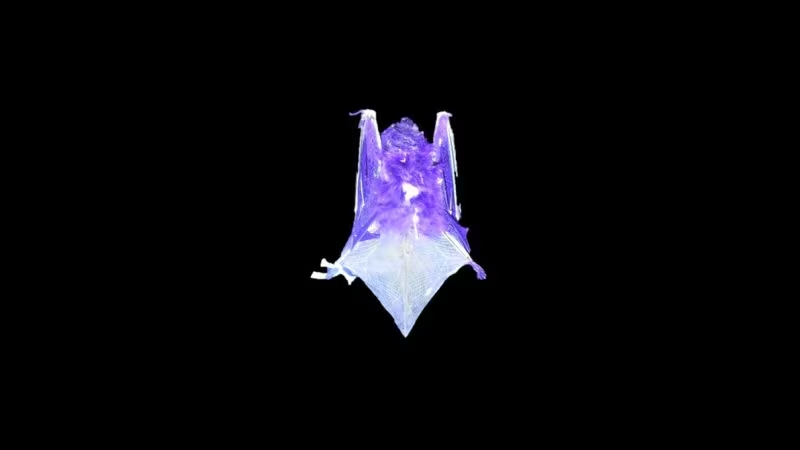The Accidental Discovery of Fluorescent Bats in Georgia
In a finding that has captured the attention of the scientific community, researchers in Georgia have confirmed that several common species of North American bats exhibit a striking phenomenon: fluorescence under ultraviolet (UV) light. When exposed to a blacklight, the bats’ fur and skin erupt in vibrant hues of pink, red, orange, and white.
This discovery, made by a team from the University of Georgia (UGA) and the Georgia Department of Natural Resources (DNR), is not only visually stunning but presents a significant biological puzzle. While fluorescence is well-documented in certain marine life, insects, and even some mammals like flying squirrels and platypuses, its presence in bats is rare and its purpose remains completely unknown.
The initial finding was entirely serendipitous. Ethan Newman, a UGA student, was using a blacklight—a common tool in bat research—to check for fungal growth related to White-Nose Syndrome on a captured bat. Instead of fungus, he observed the bat itself glowing brightly.
“It was a surprising moment. We immediately realized this wasn’t just a fluke; this was a consistent, natural trait across multiple species,” said Dr. Kristen Miller, a bat biologist with the Georgia DNR who led the subsequent investigation.
The Science of Bat Fluorescence: What Glows and How
Fluorescence is a process where an object absorbs light at one wavelength (in this case, invisible ultraviolet light) and then immediately re-emits it at a longer, visible wavelength (the colors we see). This is distinct from bioluminescence, where an organism produces its own light through a chemical reaction.
The researchers confirmed that the fluorescence is primarily concentrated in the bats’ fur and skin, though the specific chemical compounds responsible have yet to be isolated. The colors observed were varied and specific to different parts of the body, suggesting a complex biological mechanism at play.
Confirmed Fluorescent Bat Species
To date, the phenomenon has been confirmed in at least three species commonly found across the eastern United United States:
- Eastern Red Bat (Lasiurus borealis): Known for its reddish-orange fur, this species showed particularly strong fluorescence.
- Tri-colored Bat (Perimyotis subflavus): A smaller species that also exhibited clear glowing properties.
- Southeastern Myotis (Myotis austroriparius): Another common cave-dwelling species showing fluorescence.

The research team noted that the intensity and color of the glow varied significantly, not just between species, but sometimes between individuals and even different patches of fur on the same animal. This variability suggests that the fluorescent compounds might be linked to diet, age, or health status.
Why Are They Glowing? The Unanswered Biological Question
While the fact of bat fluorescence is established, the biological function—the why—remains the central mystery. Scientists have proposed several hypotheses based on the known roles of fluorescence in other organisms, but none have been confirmed for bats.
Hypotheses for Fluorescent Traits
- Camouflage or Signaling: In certain environments, particularly caves or forests where UV light may penetrate differently, fluorescence could serve as a form of camouflage or, conversely, as a signal to potential mates or rivals. However, bats are nocturnal and largely rely on echolocation, making a visual signal less likely to be primary.
- Vitamin D Synthesis: Some fluorescent compounds in mammals are precursors to Vitamin D. The absorption and re-emission of UV light could potentially be a mechanism to facilitate Vitamin D production, crucial for bone health and immune function.
- Antioxidant Protection: The fluorescent pigments might be byproducts of metabolic processes, potentially acting as antioxidants or photoprotective agents, shielding the bats from harmful UV radiation while roosting during the day.
- Accidental Byproduct: It is possible that the fluorescence serves no specific function at all. It could simply be an incidental chemical property of pigments or proteins that evolved for other purposes, such as structural integrity or coloration.

Context in the Mammalian World
While this discovery is novel for bats, it fits into a growing body of evidence showing fluorescence is more widespread in mammals than previously thought. Recent years have seen the documentation of fluorescence in:
- Flying Squirrels: Their pinkish-red glow is thought to potentially aid in species recognition or communication.
- Platypuses: The semi-aquatic monotreme fluoresces blue-green.
- Opossums: Certain parts of their bodies also exhibit fluorescence.
This trend suggests that researchers may have simply overlooked this trait in many nocturnal species due to the historical lack of UV light use in field studies.
Potential Applications for Conservation and Research
Beyond solving the biological mystery, the discovery of fluorescence holds practical promise for bat conservation and monitoring, especially given the ongoing threat of White-Nose Syndrome (WNS), a devastating fungal disease that has decimated North American bat populations.
New Non-Invasive Research Tools
Researchers are exploring how fluorescence could be leveraged as a non-invasive tool in the field:
- Species Identification: If the fluorescent signature (color, pattern, intensity) is unique to a species, it could provide a rapid, non-contact method for identification during nocturnal surveys.
- Health Monitoring: The chemical compounds causing the glow may be linked to the bat’s physiological state. Changes in fluorescence could potentially signal nutritional deficiencies, stress, or the early stages of disease, including WNS, before physical symptoms are obvious.
- Age and Sex Determination: Variations in fluorescence patterns might correlate with age or sex, offering a new metric for population demographics studies.
Dr. Miller emphasized that the next critical step is to analyze the chemical makeup of the fluorescent compounds. Understanding the chemistry will be key to unlocking the evolutionary purpose and determining if this trait can be reliably used for conservation efforts.

Key Takeaways
This unexpected finding highlights the vast amount we still have to learn about even common wildlife and reinforces the importance of using novel techniques, like UV light, in ecological studies. The key points for readers are:
- The Discovery: At least three North American bat species (Eastern Red Bat, Tri-colored Bat, Southeastern Myotis) glow brightly under UV light.
- The Mechanism: This is fluorescence—absorbing UV light and re-emitting visible light (pinks, reds, oranges).
- The Mystery: The biological reason for this trait is currently unknown, though theories include camouflage, Vitamin D synthesis, or antioxidant protection.
- The Potential: The phenomenon could become a valuable, non-invasive tool for researchers to identify species and monitor bat health, particularly in the context of devastating diseases like White-Nose Syndrome.
Conclusion
The discovery of fluorescent bats is a powerful reminder that the natural world holds surprises even in well-studied groups of animals. As researchers at UGA and the Georgia DNR continue their work to identify the specific pigments responsible for the glow, the findings could fundamentally alter how ecologists study these vital nocturnal creatures. The answers hidden in the bats’ glowing fur may not only solve an evolutionary puzzle but also provide critical new methods to protect these often-threatened populations in the years ahead.
Original author: Taylor Nicioli
Originally published: October 29, 2025
Editorial note: Our team reviewed and enhanced this coverage with AI-assisted tools and human editing to add helpful context while preserving verified facts and quotations from the original source.
We encourage you to consult the publisher above for the complete report and to reach out if you spot inaccuracies or compliance concerns.

